MIST
Magnetosphere, Ionosphere and Solar-Terrestrial
Nuggets of MIST science, summarising recent papers from the UK MIST community in a bitesize format.
If you would like to submit a nugget, please fill in the following form: https://forms.gle/Pn3mL73kHLn4VEZ66 and we will arrange a slot for you in the schedule. Nuggets should be 100–300 words long and include a figure/animation. Please get in touch!
If you have any issues with the form, please contact This email address is being protected from spambots. You need JavaScript enabled to view it..
Magnetopause ripples going against the flow form azimuthally stationary surface waves
By Martin Archer (Imperial College London)
Like waves on water, surface waves on the outer boundary of Earth’s magnetosphere, the magnetopause are thought to always travel in the direction of the driving solar wind. Indeed, many observations of the global dynamics of the magnetosphere show that disturbances travel tailward, i.e. with the wind, for both steady and impulsive driving. However, we find that the lowest-frequency magnetopause surface waves, which form standing waves along the terrestrial magnetic field, actually propagate against the flow outside the boundary.
Multi-spacecraft observations of the resonant surface waves excited by an isolated magnetosheath jet show that the speed of the waves’ energy flow is comparable, but in opposition, to the magnetosheath velocity. Global MHD simulations of the magnetospheric response to a pressure pulse reveal the inward/outward boundary motion is azimuthally stationary across a wide local time range (09-15h). This is despite significant flows being present that should otherwise advect the waves tailward. We show in the figure this is possible since the surface waves’ Poynting flux (panel a) exactly balances the flow's advective effect (panel b) leading to no net energy flux (panel c) over this local time range. Further down the equatorial flanks, however, advection dominates hence the waves travel downtail, seeding fluctuations at the resonant frequency which subsequently grow in amplitude via the Kelvin-Helmholtz instability. Our findings are also in excellent agreement with simple analytic theory. We, therefore, illustrate our overall conclusions in the right panel of the figure.
These unexpected results reveal that magnetopause surface waves can persist longer than was previously expected, which will have implications upon radiation belt, ionospheric, and auroral dynamics. Furthermore, since surface waves drive dynamics in many space, astrophysical and laboratory plasma systems, the results made possible by in situ measurements, may have applications to other environments where these are not possible, for example coronal loops.
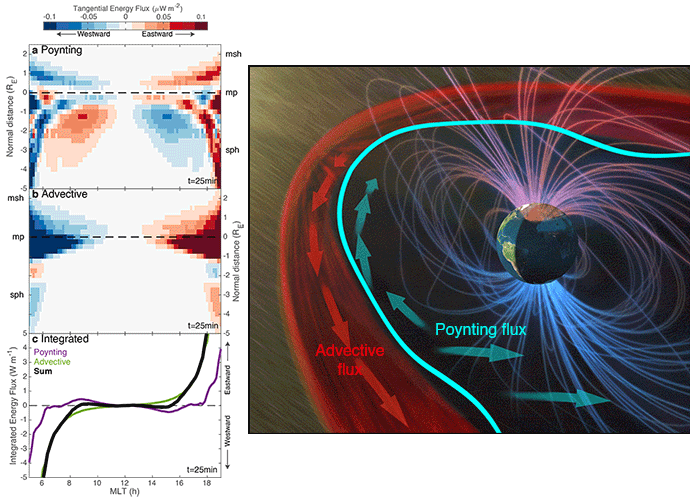
Please see paper for full details: Archer, M.O., Hartinger, M.D., Plaschke, F. et al. Magnetopause ripples going against the flow form azimuthally stationary surface waves. Nat Commun 12, 5697 (2021). https://doi.org/10.1038/s41467-021-25923-7
The Roles of the Magnetopause and Plasmapause in Storm-Time ULF Wave Power Enhancements
By Jasmine Kaur Sandhu (Northumbria University)
The Earth’s magnetosphere experiences extreme and dramatic changes during geomagnetic storms due to strongly enhanced solar wind conditions. One impact of the elevated solar wind conditions is the increased occurrence and amplitude of Ultra Low Frequency (ULF) waves across the dayside magnetosphere. These ULF waves are of particular interest due to their implications for transporting and coupling energy within the magnetosphere. However, the radial distribution of ULF wave power is complex – controlled interdependently by external solar wind driving and the internal magnetospheric structuring.
In this study, we explored how ULF wave power is distributed radially in the dayside magnetosphere. We conducted a statistical analysis of storm-time ULF wave power observations from the Van Allen Probes. The results showed that accounting for the plasmapause and (especially) the magnetopause locations reduce statistical variability and improve parameterisation of spatial trends over and above using the L value, highlighting the importance of these boundaries in controlling where and when enhanced ULF wave power is present.
A key finding was the importance of local plasma density. We find that during geomagnetic storms, high density patches in the afternoon sector (e.g. plasmaspheric plumes) act to “trap” ULF waves, leading to spatially localised patches of very high ULF wave power. Figure 1 shows one example of high ULF wave power confined within a patch of enhanced density. The results have critical implications for understanding how ULF waves propagate within the terrestrial magnetosphere, and highlights the importance of the highly distorted storm-time cold plasma density distribution on wider geomagnetic processes.
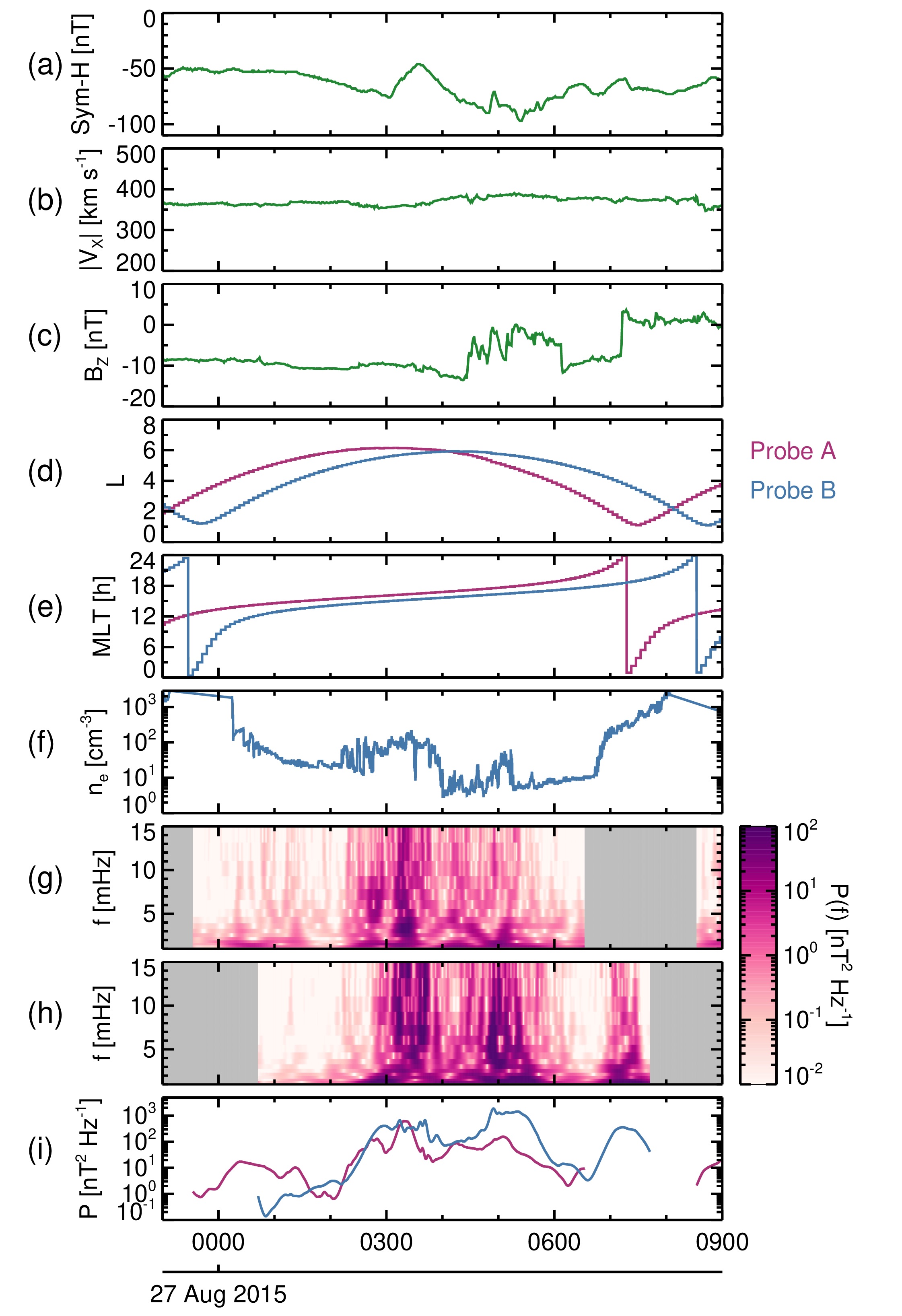
Figure 1. Timeseries for 27 August 2015 showing the (a) Sym-H index [nT], (b) Earthward component of the solar wind speed, |vX| [km s-1], and (c) Southward IMF component, BZ [nT]. Panels (d-i) show time series for the Van Allen Probes A (pink) and B (blue). We show (d) L value and (e) MLT [h] of the spacecraft location, and (f) total electron density, ne [cm-3]. Panels (g) and (h) show power, P(f) [nT2 Hz-1], as a function of frequency, f [mHz], and time for Probe A and Probe B, respectively. Panel (i) shows the power, P [nT2 Hz-1], summed over the ULF wave band.
Please see the paper for full details:
, , , , , , & (2021). The Roles of the Magnetopause and Plasmapause in Storm-Time ULF Wave Power Enhancements. Journal of Geophysical Research: Space Physics, 126, e2021JA029337. https://doi.org/10.1029/2021JA029337
Geosynchronous magnetopause crossings and their relationships with magnetic storms and substorms
By Andrey Samsonov (Mullard Space Science Laboratory - University College London)
Strengthening of magnetospheric activity is often preceded by a strong magnetospheric compression. For example, interplanetary coronal mass ejections (ICMEs) which may result in geomagnetic storms often begin with interplanetary shocks and corresponding storm sudden commencements in ground data. We investigate relations between magnetospheric compressions and magnetospheric activity in terms of the indices of magnetospheric activity (Dst, SuperMAG SML and SMU, Kp, PC). We make a list of geosynchronous magnetopause crossings (GMCs) using OMNI data and Lin et al.’s (2010) empirical model. We study which solar wind conditions accompany GMC events and which changes of the geomagnetic indices follow GMCs. We also find out which solar wind drivers result in the GMCs. Using ICME and corotating interaction regions (CIR) catalogues, we classify 74 (of 99) events as ICMEs and 18 events as stream interaction regions (SIRs) or corotating interaction regions. Furthermore, we have found that 76 GMCs follow interplanetary shocks.
During the first GMC hour, the hourly average solar wind density is usually high (larger than 20 cm-3in 70 % cases), and the hourly interplanetary magnetic field (IMF) BZ is negative (in 87 % cases). Over all events the average SMU (SML), Kp, and PC indices reach maxima (minima) in 1 hour after the GMC beginning, while the delay of the minimum of the Dst index is usually 3-8 hours. These average time delays do not depend on the strength of the storms and substorms. The SML (Dst) minimum is less than -500 nT (-30 nT) in the next 24 hours in 95 % (99 %) cases, i.e., the GMC events are mostly followed by magnetic storms and substorms. We compare solar wind and magnetospheric conditions for GMCs connected with ICMEs and SIRs. Our study confirms that the ICME-related events are characterized by stronger ring current and auroral activity than the SIR-related events. The difference might be explained by the different behavior of the solar wind velocity because the velocity at t=0 (the first GMC time) is higher for the ICME-related events (see Figure 1).
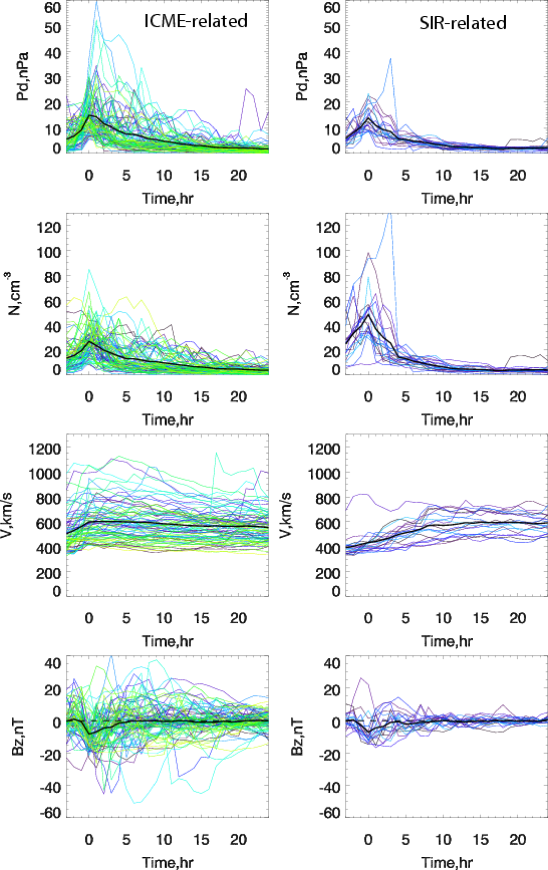
Figure 1. Solar wind conditions for the ICME-related (left) and SIR-related (right) events in the interval from 3 hours before to 24 hours after the first GMCs. Thick black lines indicate average parameters.
Please see the paper for full details:
Samsonov, A. A., Bogdanova, Y. V., Branduardi-Raymont, G., Xu, L., Zhang, J., Sormakov, D., et al. (2021). Geosynchronous magnetopause crossings and their relationships with magnetic storms and substorms. Space Weather, 19, e2020SW002704. https://doi.org/10.1029/2020SW002704.
The Importance of Sudden Commencements in Causing Elevated Ground Magnetic Field Variability
By Andy Smith (Mullard Space Science Laboratory - University College London)
Large variability in the Earth’s magnetic field can induce anomalous and damaging currents in power systems and pipelines. It is crucial that we understand and can predict the processes responsible. In this work we quantified how Sudden Commencements (SCs) contribute to creating large rates of change of the surface magnetic field. SCs are caused by the impact of solar wind pressure pulses, e.g. interplanetary shocks, on the Earth’s magnetosphere. They represent one of the more reliably forecastable forms of space weather, where the driving solar wind structure can be observed upstream of the Earth prior to its arrival.
We found that SCs are related to enhanced rates of change of the ground magnetic field (R). The Figure below shows the fraction of R in excess of 50 nTmin-1 that is related to SCs, as a function of latitude. The top panel shows the percentage observed during the SCs themselves. This maximises at around 20 – 30% at low latitudes, but drops to <1% by around 55° as other processes become fractionally more important at generating large R.
SCs often precede further magnetospheric activity, such as geomagnetic storms and substorms. The lower panel below shows the statistics for the time period during SCs, while also including the 24 hours that follow. This extended period can be seen to account for around 75% of large R (in excess of 50 nTmin-1) at locations below ~55°.
This work has shown that SCs are an important source of potentially hazardous magnetic field perturbations, and proportionally they are more important at mid-to-low latitudes. Usefully, SCs also provide a 24 hour window within which the majority (~75%) of large rates of change of the field are observed, below ~55 degrees latitude.
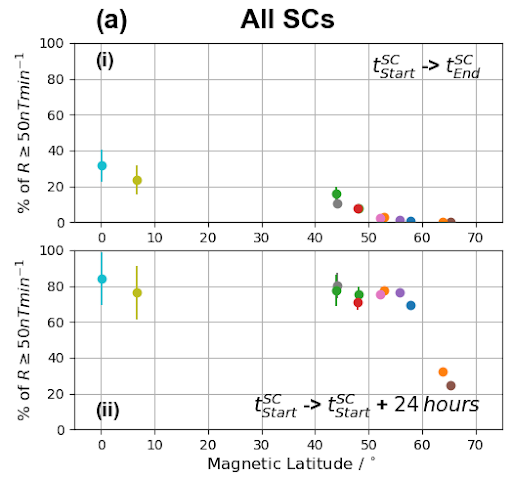
Figure 1: The percentage of observations of R ≥ 50 nT min−1 (1996 - 2016) that can be related to SCs as a function of magnetic latitude. The rows represent the data obtained during the SCs themselves (i),
and the data inclusive of 24 hours following the SC (ii).
Please see the paper for full details:
Smith, A. W., Forsyth, C., Rae, I. J., Rodger, C. J., & Freeman, M. P. (2021). The Impact of Sudden Commencements on Ground Magnetic Field Variability: Immediate and Delayed Consequences. Space Weather, 19, e2021SW002764. https://doi.org/10.1029/2021SW002764
Observations of closed magnetic flux embedded in the lobes during periods of northward IMF
By Laura Fryer (University of Southampton)
The coupling between the Interplanetary Magnetic Field (IMF) and the magnetosphere has been extensively studied over the last few decades. This has been facilitated by the launch of multiple spacecraft, such as ESA’s Cluster mission (Escoubet et al 2001), which probes different regions of the Earth's magnetosphere. There have been many studies dedicated to understanding the response of the magnetosphere during more turbulent southward orientated IMF conditions, however, there is still great uncertainty in our understanding of how the magnetosphere, particularly the magnetotail, responds to northward IMF. In general, the lobes in the Earth's magnetotail are typically described as having cool, low energy and often low density plasma populations and therefore hot plasma observations are unexpected in these regions of the magnetosphere. Despite this, there have been a small number of studies reporting energetic plasma populations in the lobes during northward IMF conditions (Huang et al 1987, Shi et al 2013, Fear et al 2014).
We present three case studies which show hot plasma embedded in the lobes of the magnetosphere. For two of these case studies, simultaneous observations of the plasma sheet confirmed that the energies observed within the lobe were directly comparable in magnitude to the populations in the plasma sheet. In addition to this, we observed plasma characteristics which indicated that the plasma is likely to be on closed field lines (evidenced by electron pitch angle distributions and variation in motion of the spacecraft). Tracing the footprint of these field lines to ionospheric altitudes revealed that in each Event, the footprint intersected with a transpolar arc. An example of this for Event 2 can be seen in Figure 1, which shows the footprint of each of the Cluster spacecraft in the tetrahedron, intersecting with a transpolar arc. This provided further evidence to suggest that the energetic plasma was likely to form on closed field lines and could be explained well by the result of recent magnetotail reconnection during northward IMF conditions, a mechanism proposed by Milan et al 2005 to explain the formation of transpolar arcs.
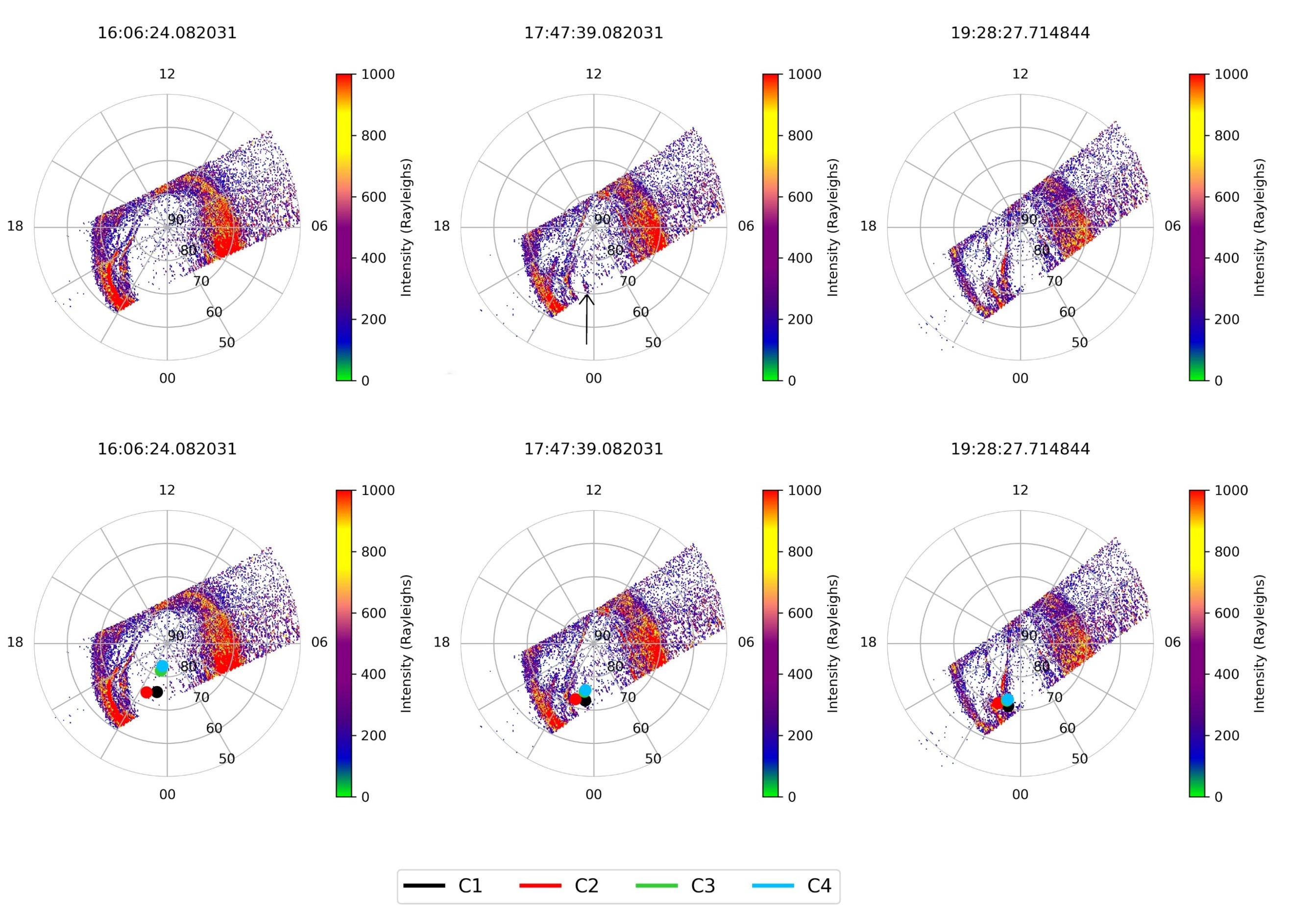
Figure 1: SSUSI (DMSP-F16) FUV auroral observations from the Northern Hemisphere. The panels show the images taken from 16:06 UT to 19:28 UT for Event 2. The data is plotted in AACGM coordinates (magnetic latitude, MLT). The top three images are repeated in the bot-tom row but overplotted with the footprints of Cluster 1, 2, 3 and 4. This has been traced using the T96 model (Tsyganenko, 1996) to an altitude of 120km and are represented by black, red, green and blue circles respectively.
Please see the paper for full details:
Fryer, L. J., Fear, R. C., Coxon, J. C., & Gingell, I. L. (2021). Observations of closed magnetic flux embedded in the lobes during periods of northward IMF. Journal of Geophysical Research: Space Physics, 126, e2021JA029281. https://doi.org/10.1029/2021JA029281